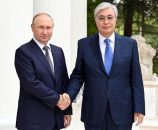Reema Shaukat
Indian Prime Minister Modi who has resumed office for the second time in India is still the same who as Chief Minister of Gujrat was. Despite assuming high political positions in India, the level of thinking which revolves around a specific mind-set is more visible now. How one can forget what not Modi tried to be the most powerful fanatic leader? Situation in Indian Held Kashmir, the wave of protests which has popped up after the declaration of citizenship amendment bill and latest reports of surge in violence in New Delhi where the mosque was attacked by fanatics, despite the presence of US President Trump in India depicted that nothing could not stop RSS followers from their activities.
Prime Minister Modi who is marking as his second tenure of premiership came up as an authority with pan-Indian vision. With the claim of world’s largest democracy, there appears in mind an image of nation-state which is just so perfect to be followed to attain splendour. It gives the impression that the leader of that alluring democracy has best knowledge about the values and virtues which pertains to so called social equality. It is precise to say that charisma and persona of named superhero attracts its countrymen to trail its footsteps. But regrettably this situation is not in favour of false assertions of Modi’s so-called democratic India. Modi earlier as Chief Minister of Gujrat and Modi as Prime Minister of India, there seems no iota of difference between the two positions conferred to him. During his tenure in past years, instances at different times have shown how India is taking Modi and how the world is reacting to his approaches. Modi belongs to a party BJP which functions under the mantra of Sangh Parivar including its factions like RSS, VHP and Bajrang Dal. This party under its insignia works on the clandestine mission of greater India. In India, school books which were distributed by the BJP government carry map of India which include not only Pakistan and Bangladesh but entire region of Nepal, Bhutan, Tibet and some parts of Myanmar under the caption of Punya Bhoomi Bharat meaning ‘India-The Holy Land’ . Mr. Modi makes sure that to make India greater he can take any giant leaps on behalf of any kind of harms to human rights or other misdeeds. India calls itself a true symbol of secularism but nowhere in the world one can see how this secularism is grassed other than India. Theoretically, Indian Constitution protects the rights of minorities, but Hindu majority led by BJP has shown complete disrespect to it and commit brutalities against Muslims, Sikhs, Christians and Dalits with liberty. The sudden and organized rise in violence and militancy by Hindu fanatic groups, belonging to different extremist Hindu organizations and political outfits under the protection of Modi government in India has alarmed the global community as well. One can easily sense, India’s rapid shift from its secularism to religious and social extremism in Modi’s government.
It was during Modi’s tenure that Indian Gujrat came under worst wave of communal violence whose footprints are still there today. Modi was given persona non-grata for the long time and was not allowed to travel to any other country, as he was declared as Butcher of Gujrat. The 2002 Gujarat riots, also known as the Gujarat pogrom, was a three-day period of inter-communal violence in the western Indian state of Gujrat. The burning of a train in Godhra on 27 February 2002, which caused the deaths of 58 Hindu pilgrims’ returning from Ayodhya is cited as having instigated the violence. Later the investigative reports suggested that as these pilgrims were returning from Ayodha after performing their rituals where earlier Babri Mosque was and after its demolition, temple was built, they tried to put blame on the Muslims of Gujrat that this was the revenge of Babri Mosque they took from Hindus. Whereas there was no truth in such allegations and Modi let the communal violence fuelled up with the blame on Muslims of Gujrat and let radicalism to seed in Indian Society. Modi was accused of initiating and condoning the violence and so was the police and government officials who allegedly directed the rebels and gave lists of Muslim-owned properties to them and thus actually marked and provided precise target to Hindus there.
Years after Gujrat riots, seems like history is repeating when a mosque has been set on fire in the Indian capital New Delhi as violent protests continue across the city with the death toll rising to 13. Video footage shared on social media showed a mob climbing to the top of the mosque’s minaret where they attempted to plant a saffron flag. One can rightly say that Modi and his Hindu nationalist BJP are undermining India’s secular ethos. India, with a population of over 1.3 billion, is 80% Hindu and 14% Muslim, which means it has one of the largest Muslim populations of any country in the world. There have been growing questions about the stance of the government, led by Modi’s Hindu nationalist party, toward India’s 172 million Muslims. Attacks on minorities, especially Muslims, have risen sharply across India in the last few years under the leadership of Modi. India’s Citizenship Amendment Act (CAA), which eases the path for non-Muslims from neighbouring Muslim-majority nations to gain citizenship, has triggered weeks of sometimes violent protests against Modi’s government. The law is seen by its opponents as discriminating against Muslims.
Hindu fundamentalism is increasingly broadening its influence everywhere and has already established a firm base of radicalism in educational sector, bureaucracy and media. The hate campaign unchecked by the extremist forces is keeping the minority anxious in defending their basic human rights and cultural identity. The RSS and other extremist elements must be checked and controlled to reduce communal riots and human rights violations. In short, Modi must review its hard lined and hawkish policies for India’s and regional peace.



